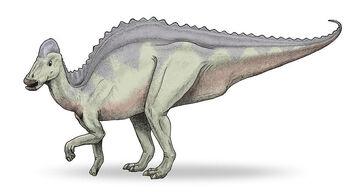
Hypacrosaurus (meaning "near the highest lizard", because it was almost but not quite as large as Tyrannosaurus) was agenus of duckbill dinosaur similar in appearance to Corythosaurus. Like Corythosaurus, it had a tall, hollow rounded crest, although not as large and straight. It is known from the remains of two species that spanned 75 to 67 million years ago, in the Late Cretaceous of Alberta,Canada, and Montana, USA, and is the latest hollow-crested duckbill known from good remains in North America. It was an obscure genus until the description of nests, eggs, and hatchlings belonging to H. stebingeri in the 1990s.Hypacrosaurus is most easily distinguished from other hollow-crested duckbills (lambeosaurines) by its tall neural spines and the form of its crest. The neural spines, which project from the top of the vertebrae, are 5 to 7 times the height of the body of their respective vertebrae in the back, which would have given it a tall back in profile. The skull's hollow crest is like that of Corythosaurus, but is more pointed along its top, not as tall, wider side to side, and has a small bony point at the rear. Unlike other lambeosaurines, the passages for the airways do not form an S-curve in the crest (at least not in H. altispinus). The animal is estimated to have been around 9.1 meters long (30 feet), and to have weighed up to 4.0 tonnes (4.4 tons). As with most duckbills, its skeleton is otherwise not particularly remarkable, although some pelvic details are distinctive. Like other duckbills, it was a bipedal/quadrupedal herbivore. The two known species, H. altispinus and H. stebingeri, are not differentiated in the typical method, of unique characteristics, as H. stebingeri was described as transitional between the earlierLambeosaurus and later Hypacrosaurus. Photographs of an adult H. stebingeri skull show an animal that looks very similar to H. altispinus.Hypacrosaurus was a lambeosaurinae hadrosaurid, and has been recognized as such since the description of its skull. Within the Lambeosaurinae, it is closest to Lambeosaurus and Corythosaurus, with Jack Horner and Phil Currie (1994) suggesting that H. stebingeri is transitional between Lambeosaurus and H. altispinus, and Michael K. Brett-Surman (1989) suggesting that Hypacrosaurus andCorythosaurus are the same genus. These genera, particularly Corythosaurus and Hypacrosaurus, are regarded as the "helmeted" or "hooded" branch of the lambeosaurines, and the clade they form is sometimes informally designated Lambeosaurini. Although Suzuki et al.'s 2004 redescription of Nipponosaurus found a close relationship between Nipponosaurus and Hypacrosaurus stebingeri, indicating thatHypacrosaurus may be paraphyletic, this was rejected in a later, more comprehensive reanalysis of lambeosaurines, which found the two species of Hypacrosaurus to form a clade without Nipponosaurus, with Corythosaurus and Olorotitan being the closest relatives.